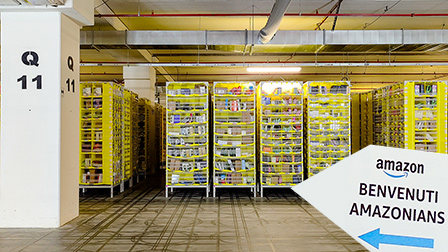|
|||||||
|
|
|
 |
|
|
Strumenti |
|
|
#1 |
|
Senior Member
Iscritto dal: Aug 2002
Messaggi: 3958
|
Switch interface e switch table. Chiarimento
Ciao
Stavo leggendo un paragrafo di un libro in inglese sul networking. Sono arrivato alla parte che tratta degli switch e la switch table, ma c'è un passaggio che non mi è del tutto chiaro. Faccio copia e incolla qui del pezzo: "To understand how switch filtering and forwarding work, suppose a frame with destination address DD-DD-DD-DD-DD-DD arrives at the switch on interface x. The switch indexes its table with the MAC address DD-DD-DD-DD-DD-DD. There are three possible cases: • There is no entry in the table for DD-DD-DD-DD-DD-DD. In this case, the switch forwards copies of the frame to the output buffers preceding all interfaces except for interface x. In other words, if there is no entry for the destination address, the switch broadcasts the frame. • There is an entry in the table, associating DD-DD-DD-DD-DD-DD with interface x. In this case, the frame is coming from a LAN segment that contains adapter DD-DD-DD-DD-DD-DD. There being no need to forward the frame to any of the other interfaces, the switch performs the filtering function by discarding the frame. • There is an entry in the table, associating DD-DD-DD-DD-DD-DD with interface y=/x (non uguale). In this case, the frame needs to be forwarded to the LAN segment attached to interface y. The switch performs its forwarding function by putting the frame in an output buffer that precedes interface y. Let’s walk through these rules for the uppermost switch in Figure 6.15 and its switch table in Figure 6.22. Suppose that a frame with destination address 62-FE-F7-11-89-A3 arrives at the switch from interface 1. The switch examines its table and sees that the destination is on the LAN segment connected to interface 1 (that is, Electrical Engineering). This means that the frame has already been broadcast on the LAN segment that contains the destination. The switch therefore filters (that is, discards) the frame. Now suppose a frame with the same destination address arrives from interface 2. The switch again examines its table and sees that the destination is in the direction of interface 1; it therefore forwards the frame to the output buffer preceding interface 1. It should be clear from this example that as long as the switch table is complete and accurate, the switch forwards frames toward destinations without any broadcasting. In this sense, a switch is “smarter” than a hub. Il punto che mi è poco chiaro è il due. Che poi mi sembra approfondito qui "Let’s walk through these rules for the uppermost switch in Figure 6.15 and its switch table in Figure 6.22. Suppose that a frame with destination address 62-FE-F7-11-89-A3 arrives at the switch from interface 1. The switch examines its table and sees that the destination is on the LAN segment connected to interface 1 (that is, Electrical Engineering). This means that the frame has already been broadcast on the LAN segment that contains the destination. The switch therefore filters (that is, discards) the frame" Arriva un frame con destinazione se stessa?? Aiutatemi a capire, c'è qualcosa che mi sfugge. Grazie |
|
|

|
|
|
#2 | |
|
Senior Member
Iscritto dal: Apr 2005
Messaggi: 3220
|
Quote:
Penso sia un caso dato da 1) Strani giri di pacchetti sulla rete (ad esempio faccio appositamente un pacchetto mal formattato per floodare lo switch o roba del genere) 2) dovrebbe essere collegato a pacchetti di broadcast o qualcosa di simile. c'è anche un caso che mi viene in mente che potrebbe essere quando c'è di mezzo un HUB. Poni ad esempio che due X e Y sono collegati all'hub H. Poniamo inoltre che a questo hub ci sia collegato poi su una terza porta uno switch. Se X vuole parlare a Y manda un pacchetto da mac(x) a mac(y). Ovviamente essendoci un hub il pacchetto va ANCHE allo switch il quale, vede, dalla sua switch table, che quel MAC address è già su quella interfaccia e quindi scarta il pacchetto. Spero di essere stato esausitivo. |
|
|
|

|
|
|
#3 | ||
|
Senior Member
Iscritto dal: Aug 2002
Messaggi: 3958
|
Quote:
ma qui stai parlando del mac address di X?: Quote:
Grazie Ultima modifica di lucas72 : 08-05-2019 alle 20:11. |
||
|
|

|
|
|
#4 | |
|
Senior Member
Iscritto dal: Apr 2005
Messaggi: 3220
|
Quote:
Ok faciamo un esempio: Prendi questo schema  Se PC 1 di Laboratorio 1 vuole dialogare con pc 2 sempre di laboratorio 1, manda un pacchetto dalla sua scheda di rete verso l'hub. Ovviamente l'hub (che non fa swtiching per l'appunto) rimanda il pacchetto su tutte le porte. Oltre ad arrivare quindi al pc 3 di laboratorio 1 (che lo ignorerà in quanto non destinato a lui) e, correttamente, al pc 2 (che lo accetterà), arriverà ANCHE allo switch 100. Lo switch, che è più furbo, verifica se deve inoltrare o meno il pacchetto, basandosi sulla sua switch table, e lo scarterà poichè lui SA che il pacchetto che proviene su quella porta deve essere inoltrato a un MAC ADDRESS che, sulla base della tabella, è collegato alla stessa porta sorgente. Dettagliamolo: Mac (li tronco per brevità) di: Pc1 AA.AA.AA Pc2 BB.BB.BB Pc3 CC.CC.CC mettiamoci anche quelli del laboratorio 2: Pc4 XX.XX.XX Pc5 YY.YY.YY Pc6 ZZ.ZZ.ZZ Ora facciamo la tabella dello swtich PORTA 1 -> Mac conosciuti (AA.AA.AA, BB.BB.BB, CC.CC.CC) PORTA 2 -> XX.XX.XX, YY.YY.YY, ZZ.ZZ.ZZ Nell'esempio di prima, come potrai notare cè il pacchetto AA.AA.AA che deve andare verso BB.BB.BB. Lo switch, quando verificherà SRC e DST, noterà che sono entrambi sulla stessa porta (colpa dell'hub, che ha ritrasmesso i pacchetti su tutte le porte) e quindi ragiona "ma come è possibile che mi arriva un pacchetto che deve tornare da dove è venuto? allora lo scarto". Spero di essere stato esaustivo |
|
|
|

|
|
|
#5 |
|
Senior Member
Iscritto dal: Aug 2002
Messaggi: 3958
|
Si si, penso di aver capito ora. Grazie tante
|
|
|

|

|
| Strumenti | |
|
|
Tutti gli orari sono GMT +1. Ora sono le: 01:15.























